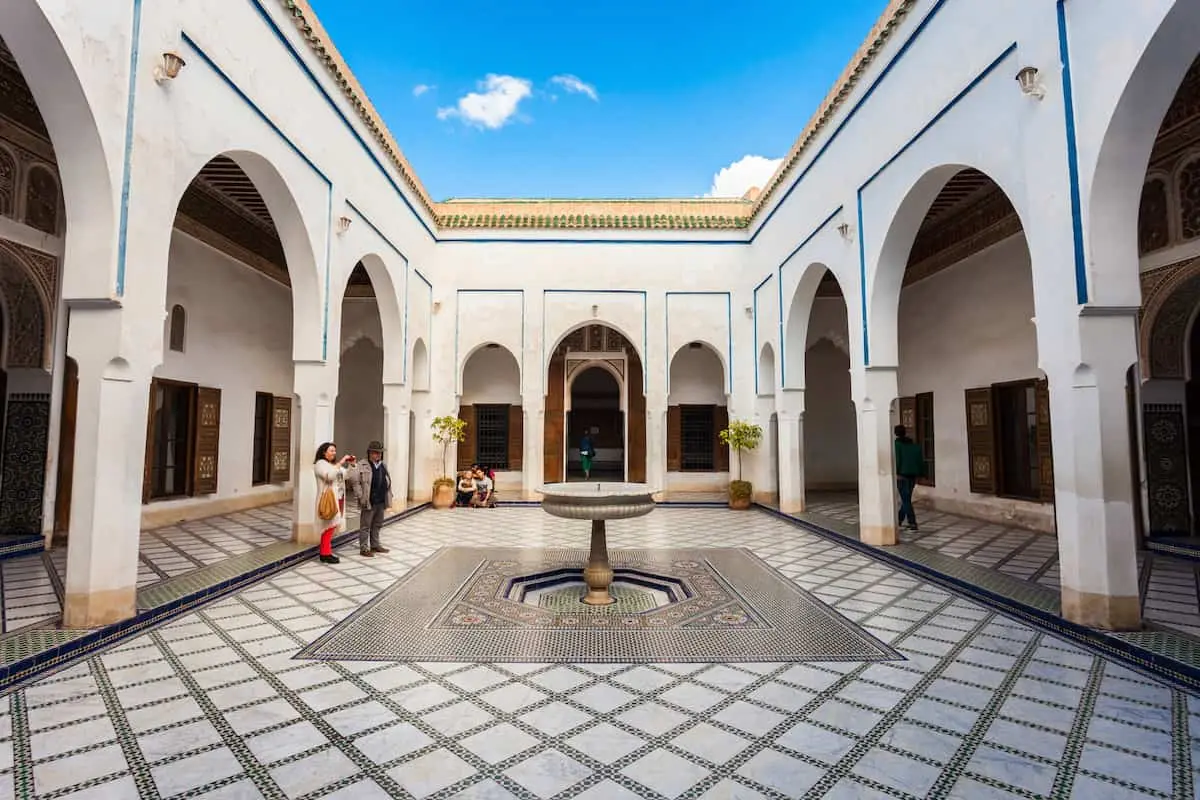Bahia Palace Marrakech: History, Architecture, and Cultural Significance
The Bahia Palace, in Marrakech, is one most astonishing castles in Morocco, having its beauty, splendour, and successful borrowing of Moroccan artistic styles. Its establishment dates to the early 1890s, and in the original design, the idea was to create not only the most opulent palace worked on the building but such a signifying potency and wealth. Many years later, Bahia, with its fantastic Islamic and Moroccan architecture, manages to attract people from all around the globe with its beauty.
The meaning of the word Bahia directly speaks of it; either “brilliance” or “beautiful”. This is how it would be defined, bearing in mind the factual features it possesses. The courtyards covering vast areas, the stamped tiles, calligraphic ceilings, and the well-maintained gardens provided with rows of orange trees surrounded by fountains, this is how the Bahia Palace of Marrakech looks when presented by Moroccan expert hands. Every element reflects the pre-existing designs and the old Moroccan designs, which have molded a rich architectural heritage over the years.
Bahia Palace is famous for its magnificent appearance as well as the information about our ancestors. This building was a residential one of those reigning for the vizier’s praise and attraction in the 19th century, where it was viewed as a measure of wealth and power. It was repurposed and has an unforgettable history associated with the colonists of modern-day Morocco. It can be rightfully used as an excellent example of a living concept referring to the past of the country, as it showcases the architectural splendor of ancient Marrakech, which used to be a melting pot of so many cultures and genres of arts up to this day. Lastly, there is are lot to read about Cities In Morocco.
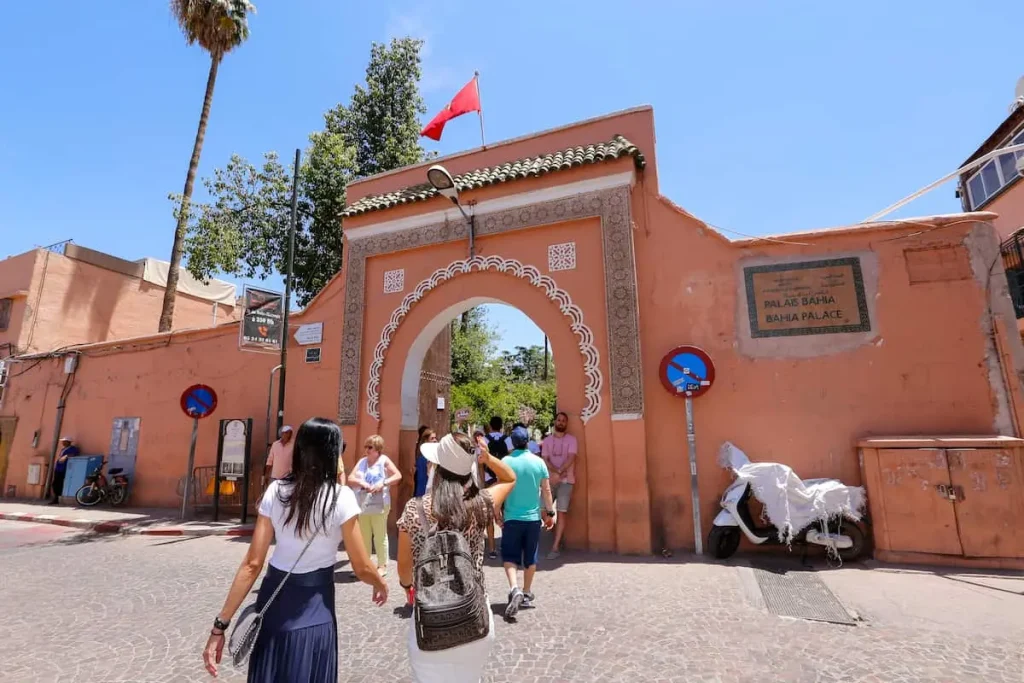
1. Location and Overview of the Bahia Palace, Marrakech
Situated in the Moroccan ancient walled city, Marrakech and its palaces, including the Bahia Palace, are however domestic. The other essential destinations in the town are the Mellah (the old Jewish quarter) and the Jemaa el-Fnaa, the main square. This is ideal for those who choose to stay in or around the old city and would wish to engage in any tour within narrow streets to stumble into something as magnificent as the royal home.
A part of the palace occupies an area of more than 8 hectares (about 20 acres) and is one of the grandest architectural constructions in Marrakech. This vast complex was designed to be a perfectly outfitted domicile with numerous courtyards, beautiful green gardens, and even glittering reception halls. Presently, history does not allow full access to the inner part of the palace, though the quality of the few exhibited artworks never fails to impress.
The connotation of the term “Bahia” in its primary definition carries the concept of shining and attractive. This is indeed true as the Bahia lacks any kind of adjectives for her rare interior composes from the thinnest ornamental stucco tracery on the walls to the most incredible zelija patterns. Located in the centre of a large garden of trees of bitter orange with fountains, providing a peaceful environment of people filled with water, glistening jasmine, and away from the reddish mud, Bahia Thi Ana is always serene for a visitor.
The Bahia is both a building and a gateway for those who wish to engage with Moroccan culture, knowing its decorative and Intellectual aspects.
2. History of the Bahia Palace, Marrakech
At that time Bahia Palace was not created by a sultan, and Si Moussa, who was then the sultan’s Grand Vizier, had it constructed as low buildings with a clear aim. It was of miniature scale but very refined in its construction. The works were started by Ba Ahmed, the son of Grand Vizier Si Moussa, after his death, extending the construction by building another structure. Whereas the previous construction was of a modest inclusion, this was intended to be on a grand scale. Even though Ba Ahmed had been the Community, he at one stage revived adversities by means of the ambivalent enterprise, the Palace. The palace also incorporated a further development with more constructions that had different uses. These were courtyard pavilions, gardens, and embellished parlours.
After France’s occupation of Morocco, the palace was received by the French authorities as a residence and the administrative division of the French protectorate in Morocco. The best part concerning this palace is that most people kept it that way, which ultimately has prolonged its magnificence even up to this generation.
These days, the Bahia Palace often serves as one of the principal tourist attractions in Marrakech, attracting many visitors. There is a widespread desire to enjoy the picturesque places of this masterpiece of human architecture, from separate zillij designs that depict white marbles to the honeycomb stucco decorations and the magnificently hewn cedar beams. The narrative of the establishment reflects its history as a seat of power of a dynasty, a colonial epicenter, and as a depository for the cultural artifacts of the people of Morocco, thereby making the said monument very much a people than a people’s monument.
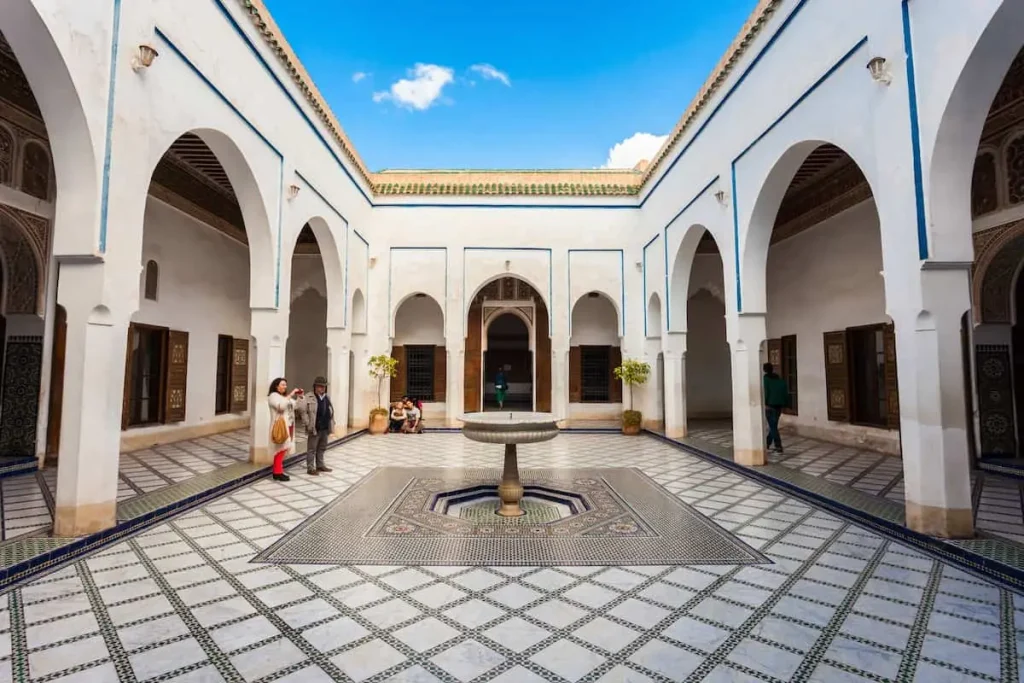
3. Architecture and Design of the Bahia Palace, Marrakech
The Bahia Palace is a masterwork of traditional Moroccan and Islamic architecture that is a century and a half old. When one enters it, one sees great beauty and finely balanced aesthetics serving useful purposes and underscored in the history of Morocco.
Sharing the attention of its visitors mainly with the gardens and inner courtyards, the palace offers room after room without feeling claustrophobic. Higher walls are entirely in zellige, beautifully bright and complex designs made of small tiles in different colors. The stucco-carved walls and arches, along with the cedar-wood panelled ceilings, showcase the Moroccan artisans’ talents.
The Bahia Palace comprised over 150 rooms in the beginning, but today, the public only has access to a fraction of these rooms. They were reserved for the vizier’s family and visitors, each decorated uniquely in terms of privacy and amenities. As one meanders through the palace, they come across opulent reception halls, cosy chambers, and grand salons, all representing epitomes of the opulence of the Moroccan aristocracy.
Outside the palace, beautiful gardens take over with green lawns, refreshing fountains, and orange and jasmine trees intermixed. This setting serves as a welcome break from the busy medina. The well-thought-out composition shown through the architecture, as well as the natural characteristics, exemplifies the architectural convention of historical Moroccan social organization.
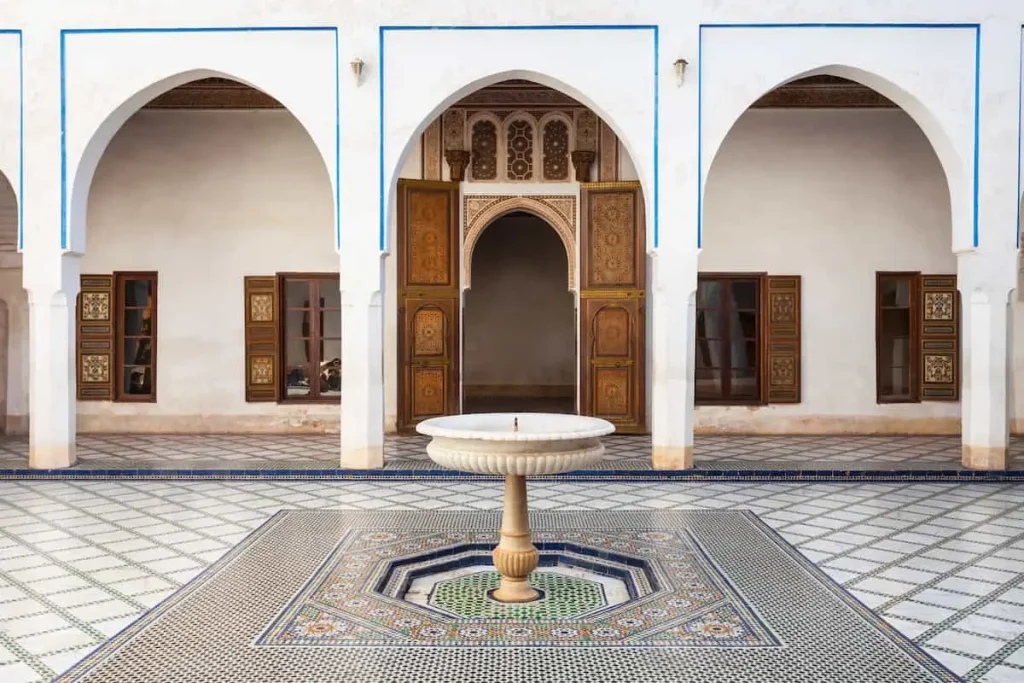
4. Cultural and Historical Significance
The Builder’s House, for its exquisite architecture and ornamentation, a visible embodiment of the Moroccan arts and crafts of the 19th century, remains one of the most imposing structures in Marrakech, even in terms of its modern accessory buildings. A tribute has been reserved for every architect or artisan, including the one responsible for shaping the intricate wood tracery; no corner was left neglected on the design table. By some tier, some sections even go higher or lower than they should, but the impact of each creation surpasses all these minor irregularities because of the sheer form of grandeur and beauty of the picture.
As Marrakech was under French rule in the twentieth century, the Bahia Palace remained an important political and representative institution, perpetuating the historical function of this Palace. Presently, it is still highly regarded and held in high esteem by many people living in Marrakech as well as tourists, and contributes to bridging the history with today. Through its halls and gardens, the exquisite decor of the Moroccan nobility flourishes as the works of art representative of Moroccan culture are found within the same context.
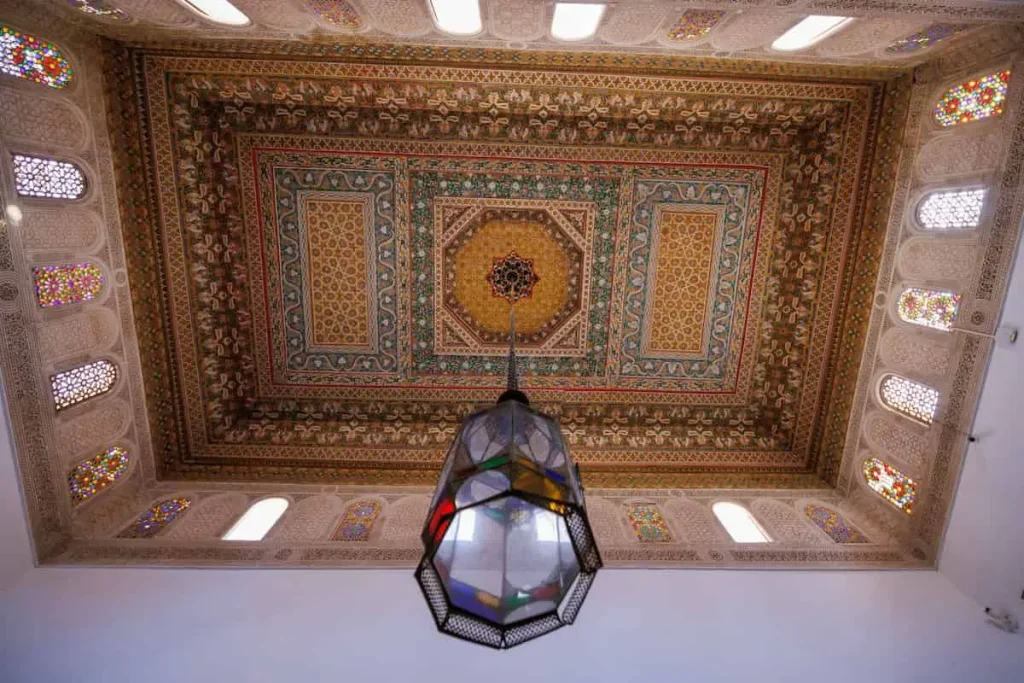
5. Visiting the Bahia Palace, Marrakech
There are several reasons why people visit the Bahia Palace in Marrakech, and one of these reasons happens to have ties to its location within the city. The Bahia Palace is situated a little bit further from the Marrakech medina, so one wouldn’t struggle to arrive by walking or having a taxi, nor would it take long to get through its fillers if on a planned tour.
More often than not, you can expect the doors to be open at certain fixed times, such as from 9 am to 5 pm, and expect to pay a small amount of money for entrance into the palace. One should know that tickets for the entry can be ordered in advance by most the tourist groups, and they normally cost a certain amount. A visit to the palace is further elaborated with guided tours that are prepared for all those who want to know about the history and all the architectural aspects of this luxurious building.
Tips for Visiting the Bahia Palace in Marrakech
Should you wish to maximize the enjoyment of moments during the trip, I would advise going as early as possible in the morning or as late as possible in the evening. The golden hours let you take great pictures when most visitors have already explored the place, and the light serves as a perfect hand. To give a list of more details, everybody will definitely want to take pictures at more beautiful places in the royal area of Morocco, such as designed yards, colored tile arches, and gardens with trees of oranges and jasmine. Let us know that, in case you want, one can walk through this wonderful edifice because it is more segmented and has many more establishments, and one may do this just as well.
Attractions within most palaces are closed to visitors for security reasons. The prime location overlooking the town and hard-to-reach, steep, narrow lanes and changing heights, makes it difficult for people to move around this building; nevertheless, it is open to the public to see. Besides being an entertaining and visually appealing experience, this journey across the palace allows people to learn about the fascinating historical narratives of the Moroccan royal families.

6. Bahia Palace, Marrakech in Modern Times
Presently, the Bahia Palace is not just an archive of historical pieces; it is perceived as one of the art centers. It is one of the most popular attractions, and no wonder, the sight is a very beautiful one. Its history and architecture appeal to tourists from various parts of the globe, and they can be found around it all the time. The banayan tree, which still exists in Marrakech, is still in its premises. It can be accessed readily because the palace and all other types of mosaics and gardens are available to the people.
Attending to official ceremonies and cultural functions, the Bahia Palace still retains a bit of importance. It provides wide halls and courtyards, which are best suited for the organization of art events as well as concerts and government functions. This part contributes to the palace’s significance as a precious heritage and a living element of Moroccan culture.
From a young age, this palace has served as an interface connecting different eras. Though it vividly embodies the standards and lifestyles of the privileged classes within 19th-century Morocco, it assists Marrakesh in the activities of safeguarding and fostering heritage. On this account, visiting the Bahia Palace in Marrakesh today is an exercise of not just going back in time, but also an awareness of the manner in which Morocco still holds in high regard its customs and softens them in the eyes of the visitors.
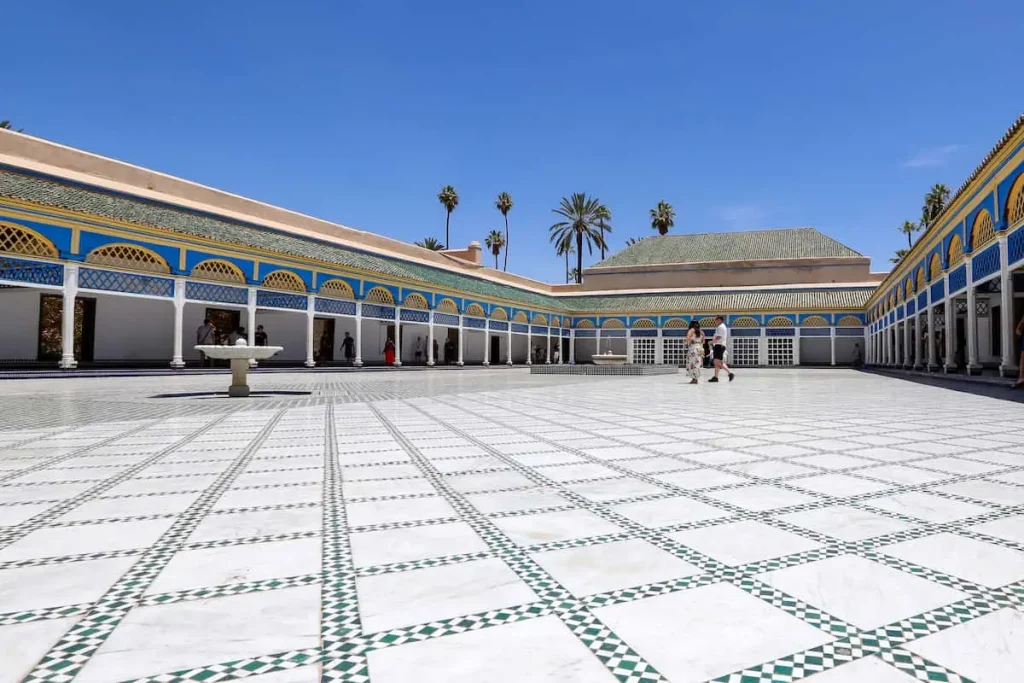
7. Quick Facts About the Bahia Palace, Marrakech
-
The Bahia Palace was built in the late 19th century by Grand Vizier Si Moussa.
-
It was later expanded by his son, Ba Ahmed, to display power and wealth.
-
The palace contains over 150 rooms, though most are empty and closed to visitors.
-
Its most famous feature is the vast marble courtyard, decorated with zellige tiles.
-
The palace covers about 8 hectares (20 acres), including gardens and courtyards.
-
The name “Bahia” means “brilliance” or “beautiful” in Arabic.
-
The gardens are filled with orange trees, jasmine, and fountains, creating a peaceful atmosphere.
-
It is regarded as a masterpiece of Moroccan and Islamic architecture.
-
The palace was used by French colonial authorities during the early 20th century.
-
Today, it is one of the top tourist attractions in Marrakech, visited by thousands daily.
8. What to See in the Bahia Palace, Marrakech
-
The Grand Courtyard – A vast marble courtyard surrounded by elegant arches and decorated with colorful zellige tiles, perfect for photos.
-
The Small Courtyard (Cour d’Honneur) – A more intimate space once used by the harem, with intricate stucco and woodwork.
-
Ornate Ceilings – Hand-painted cedar wood ceilings with floral and geometric designs showcasing Moroccan artistry.
-
Zellige Tilework – Stunning mosaics covering floors and walls, each piece carefully cut and arranged into geometric patterns.
-
Carved Stucco Walls – Detailed plasterwork with calligraphy, arabesques, and lace-like motifs.
-
The Harem Rooms – Private living spaces of the palace women, decorated with traditional craftsmanship.
-
Gardens and Fountains – Peaceful spaces with orange trees, jasmine, and water features reflecting Moroccan garden design.
-
The Reception Rooms – Lavishly decorated halls where Ba Ahmed hosted important guests and officials.
-
The Hall of Honor – A grand chamber designed to impress with its scale and decoration.
-
Royal Quarters – Elegant living spaces reserved for Morocco’s elite during the 19th century.
9. Conclusion
The ancient Marrakech square is a place full of wonder. It is the current home of the Bahia Palace, which is distinctive for being an example of history and realism. The actual palace was a 19th-century-built monument dedicated to status and beauty, a description that has allowed its existence to the present times… ornate mosaics, delicately engraved stucco, colored, painted, and carved ceilings, and the well-kept gardens around it. One can easily deduce from the different paintings used on the walls of Bahia, its corridors, and comfortable rooms examples of settings that wealthy people in every society in Morocco are used to, demonstrating things that can now be referred to as ‘cultural heritage paintings’ of Bahia in historical perspective, and the skills of the Moroccans are exemplary.
Even though it’s an old country, all historical buildings and structures in Morocco/Marrakech cannot be termed as dead or, let’s say, without a historical background for decades, coupled with beautiful arts and crafts. They are ever capable of addressing the aesthetic, cultural, or design needs of literally everybody from every nook of the globe, including children of the same age. In Morocco, a place decorated as the UNESCO World Heritage has many historical places, and if one is more into artificial infrastructure or the history of cities, or is a peaceful countryside lover, then the Bahia Palace is one of the points of interest worth visiting.

